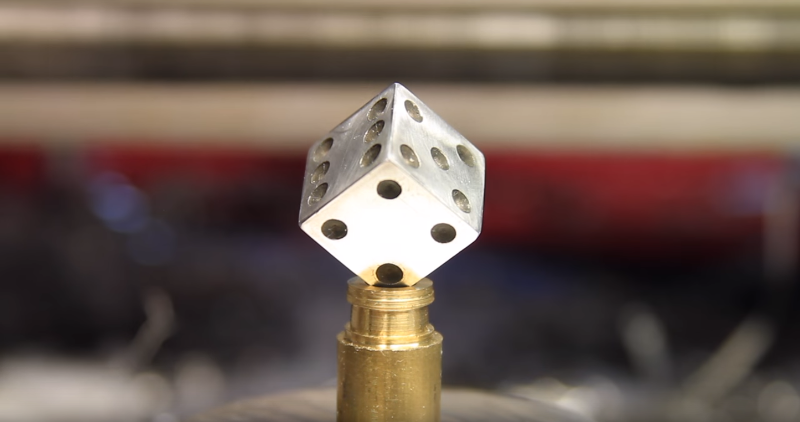[Tim] was tired of using his lathe to turn round things. He decided to make a gaming die—something that’s iconically square—out of cylindrical scrap. As it turns out, this is possible to do on a lathe with a three jaw chuck. [Tim] discovered that the bevel on the jaws will hold a cylindrical puck of scrap sideways while he squares off the round sides into faces.
Turning a cube on a lathe looks pretty fiddly, so we applaud [Tim]’s lovely handiwork even more. As you’ll see in the video down below, things were going gangbusters until he went to make the last facing cut. Maybe the tool wasn’t lined up just so, or something was off in the chucking, but the first pass made a bit of a gouge in the stock. Looks like it was easy enough to fix, though. After four 90° turns and facing cuts, he had a nice looking rough cube to work with.
This is a regulation-sized die, so the next step was to trim it down to 16mm³. Then it was time to sand, polish, and add the dots. To lay them out, [Tim] sprayed the cube with layout fluid and scribed unique line patterns on each face. Then he drilled the indentations and filled them in with aluminium black.
Most of the dice we see are electronic, like this extremely random pair and these PIC-driven LED dice. We’d like to see [Tim] make a second D6 so he has a pair. And then make a D20. Please?
















Turners cubes are a common show of lathe skill. There are some really elaborate designs that can be seen in a Google search.
A simple die is not the same as a turners cube, and it isn’t “fiddly” as the post says. It’s a very simple operation. IIRC, it was the first lathe project we did in middle-school metal shop.
well done. I like. What spray did you use for the finer hand sanding? at 6:33ish? Thanks.
WD-40. eewwwww.
Did six months time in a tool and die shop at 17 (High school). Boss man used WD-40 on every piece of aluminum ever that he cut. To this day I can’t tell which I like more, the smell of a summer barbecue or the smell of WD-40 – cooled aluminum shavings smoking hot! Mmmmmm . . .
that’s probably one of the only real-use case of WD40, but even here odorless petrol fluid is cheaper.
I find ethanol to be the best cutting fluid for aluminium
Yep. That aluminum dust phlegm can be hard to cut with just water. Gargling gin will do the trick.
“use case of” you are killing me! Save the world. Ban “use case”, “corner case”, “edge case”. Use the classical “example” and “boundary condition”. I need a name for the movement. This is a good use-case for social media!
It looks like a spray-can of WD40
Great example of making rectangular parts with a lathe…squared up many blocks that way before I got a mill. You can also grab an endmill in the chuck and fixture the work on the cross slide for slotting if needed. If you’re feeling extra masochist you can turn with a mill too…
Then what do you call someone who turns with a drill press? (hey, if it works, it ain’t stupid. Dangerous, yes.)
Stumpy
I don’t think modern medicine has a term for that…but by god you have to do what you have to do.
Uhm… Degloving might fit
Shopsmith user.
Turning with a drill press isn’t too bad, if you take it slow and use files. Along with a v-block I could make nice parts to within 0.05mm tolerance no problem.
Im impressed… But as its a single, its die – when he makes two – then it can be a pair of dice
A cube of 16mm³ would have sides of ca. 2.5mm in length and it would make a nice dice for ants. Here, the side is 16mm.
So it’s rather (16 mm)³ instead of 16 (mm)³?
Yes, I know, I know…
https://www.youtube.com/watch?v=37s2EAvTyS0
Nice work!
Oh my god, just get a 4-jaw chuck. They’re so cheap on ebay and make turning rectangular things a dream.
Agreed. One of the side-effects of a regular machining video watching habit is the instant reaction “OMG why is there a three-jaw chuck on that thing?!?” regardless of what is being turned…
A small detail about making dice: The depressions in the sides shift the center of gravity slightly. In order to make the die “fair”, adjustments need to be made, I know there are requirements for which number is on opposite faces, but does anyone with knowledge of the subject care to chime in on how to make a fair die?
The arrangement is more to make it harder to control the die while throwing, if you are off one face, you get a very different number.
As far as offsetting the drillout, the voids are typically filled with something the same density the rest of the dice is made of, just in a contrasting color.
Casino dice are made with filled pips to avoid that problem. If you’re making your own dice, use a balancing caliper on a level surface and deepen the pips the lower number sides if you can’t fill them with material the same density as the body.
Relatedly, if you need to roll odds/evens, check your d10s because some are manufactured with all odds/evens on the same side and are easy to force. Similarly, spindown dice are also easy to force high/low.
Opposite faces must add up to seven.